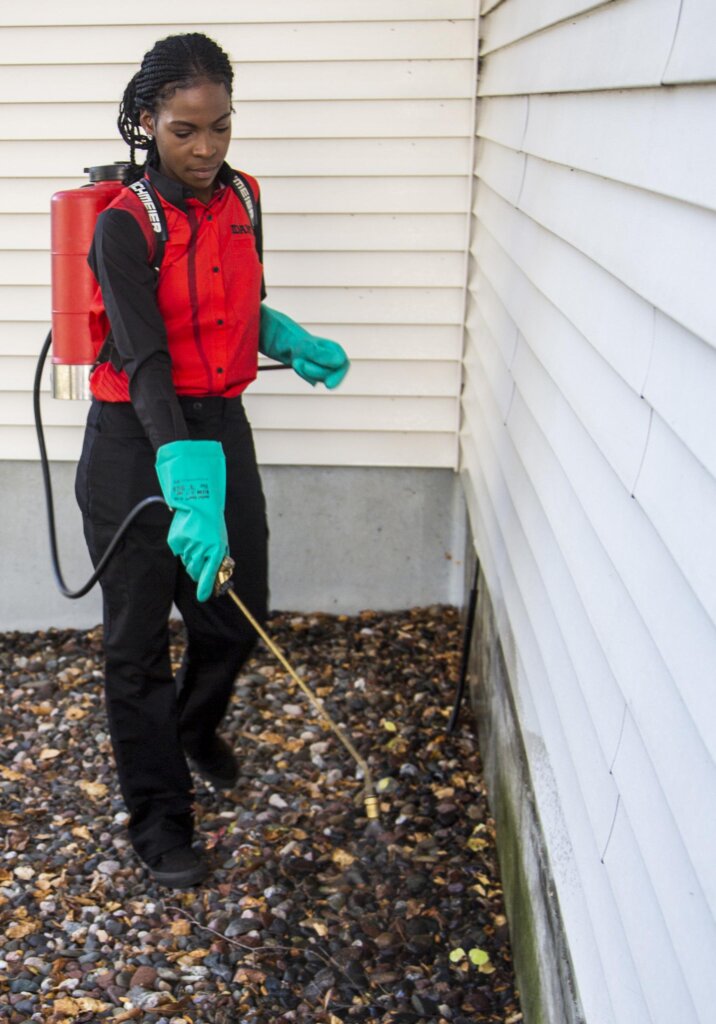A1 Bed Bug Exterminator Charlotte - Specialized Bed Bug Removal
A1 Bed Bug Exterminator Charlotte - Specialized Bed Bug Removal
Blog Article
Bed Insect Treatment Break Down: Contrasting Chemical Vs. Non-Chemical Solutions
In the realm of pest control, specifically when taking care of the persistent issue of bed pests, the option in between chemical and non-chemical treatment services can be a crucial one. Both strategies provide distinct advantages and drawbacks, influencing variables such as performance, security considerations, and total cost. By examining the nuanced details of each technique, a clearer understanding of which path to pursue in addressing a bed insect infestation can be achieved.
Performance of Chemical Treatments
Chemical treatments for bed bug invasions have been extensively recognized for their powerful and fast efficiency in getting rid of these pests. When thinking about the effectiveness of chemical therapies, it is essential to comprehend that they can give a quick and detailed option to a bed insect issue. Professional pest control men frequently count on pesticides to target bed insects at various stages of their life cycle, consisting of eggs, fairies, and grownups. These chemicals normally work by interrupting the bed bugs' nerves, resulting in paralysis and ultimate fatality.
Additionally, chemical treatments have the benefit of providing recurring impacts, implying that they can proceed to remove bed bugs also after the preliminary application. This recurring action is particularly useful in combating any type of possible re-infestations. In addition, the rapid action of chemical treatments can bring alleviation to individuals facing extreme bed insect problems, enabling them to restore control of their living spaces promptly.
Security Problems With Chemical Solutions
When using chemical remedies for bed pest treatment is making certain the safety and security of owners and the atmosphere,One vital aspect that requires cautious factor to consider. While chemical therapies can be reliable in eliminating bed insects, they may posture threats otherwise handled effectively. Among the key security worry about chemical solutions is the possible harm they can cause to human wellness. Direct exposure to specific chemicals made use of in bed pest therapies can lead to respiratory system problems, skin irritation, or other adverse responses, especially in people with pre-existing conditions or sensitivities. Furthermore, inappropriate application or dosage of chemical pesticides can lead to hazardous deposits remaining in the cured area, positioning long-term health and wellness risks to passengers.
Furthermore, the ecological effect of chemical solutions is another considerable consideration. Some chemicals utilized in bed insect therapies might be damaging to advantageous insects, wildlife, and ecological communities if they seep right into the soil or water supply. It is crucial to utilize chemical treatments judiciously, complying with security standards, and thinking about less harmful choices to mitigate these dangers and guarantee the secure and reliable administration of bed pest problems.
Benefits of Non-Chemical Techniques
Thinking about the prospective security concerns and environmental influence linked with chemical services for bed pest treatment, discovering non-chemical techniques visit this web-site presents a promising alternative with a number of distinctive advantages. Non-chemical treatments are eco friendly, as they do not add to air or water contamination, making them a lasting selection for insect control.
Additionally, non-chemical options can be efficient in targeting bed insects, including hard-to-reach areas where chemical therapies may not penetrate - A1 bed bug exterminator charlotte. Approaches such as heat treatment, vacuuming, steam cleansing, and bed mattress encasements supply detailed removal without the use of dangerous chemicals.
Limitations of Non-Chemical Treatments

Furthermore, non-chemical therapies usually call for numerous applications to achieve successful obliteration. This can be lengthy and may not constantly guarantee complete elimination of all bed insects and their eggs, specifically in hard-to-reach or covert places.
Furthermore, the success of non-chemical treatments heavily relies upon proper application and thoroughness, which can be challenging for people without expert knowledge. Poor application of non-chemical techniques may lead to insufficient obliteration, bring about relentless infestations and the demand for added therapies.
Consequently, while non-chemical therapies have their advantages, it is vital to acknowledge these limitations and consider them when identifying the most reliable approach for handling bed bug problems.
Cost Contrast: Chemical Vs. Non-Chemical Options
Provided the constraints related to non-chemical therapies, a necessary element to assess in the context of bed bug management is the price contrast in between chemical and non-chemical options. Chemical therapies generally involve the application of pesticides by professionals, which can range from $250 to $900 per area, depending upon the severity of the infestation and the dimension of the location to be treated. In contrast, non-chemical treatments like warmth therapy or steam can be much more expensive, with expenses ranging from $1,000 to $6,000 for a whole home. While the initial expense of chemical treatments might appear lower, several treatments might be needed to totally eliminate the infestation, potentially enhancing the total price. On the other hand, non-chemical alternatives might supply a more environmentally friendly and sustainable service, although they can be cost-prohibitive for some individuals. Eventually, when considering the cost of bed pest proof bug treatment choices, it is essential to consider the upfront expenses against the performance and lasting sustainability of the selected technique.
Conclusion

Thinking about the possible security issues and environmental effect linked with chemical options for bed bug treatment, checking out non-chemical strategies offers a promising option with a number of unique benefits.Offered the constraints associated with non-chemical therapies, a crucial element to examine in the context of bed pest management is the cost comparison in between chemical and non-chemical alternatives. In contrast, non-chemical treatments like warmth treatment or vapor can be more pricey, with costs ranging from $1,000 to $6,000 for an entire home. While the preliminary price of chemical therapies might appear reduced, numerous treatments may be required to completely eradicate the problem, possibly enhancing the overall price.In verdict, when contrasting chemical and non-chemical bed pest treatment options, it is crucial to take into consideration performance, security, benefits, limitations, and cost.
Report this page